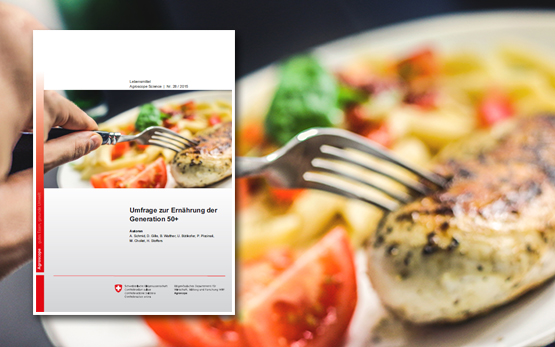Berger T., Aeschlimann T., Haldemann J., Fehér N., Winkler H.
Beurteilung von Schweizer Käse bezüglich der ParaTB-Anforderungen für den Export in die EAWU: Beurteilung z.H. Plattform Agrarexport (PAE).
Hrsg. Agroscope, 29. Januar, 2024, 3 S.
Schwendimann L., Berger T., Graber H. U.
Staphylococcus aureus and its enterotoxin: A Review.
Agroscope Science, 180, 2024, 1-69.
Manser T.
Ziegenzucht in der Schweiz.
In: Vorlesung zur Ziegenzucht in der Schweiz. 25. Oktober, Hrsg. Uni Bern, Bern. 2023, 1-24.
Ingenhoff J.-E.
Mineralölrückstände in Milchprodukten.
Agroscope Transfer, 505, 2023, 1-7.
weitere Sprachen: französisch | englisch
Fritsch L., Berger T.
Aktuelles aus der Listerien-Beratung Agroscope.
In: Berater-Tagung Deutschschweiz. 7. November, Hrsg. Agroscope, Olten. 2023, 1-36.
Kagady N., Chernova O., Lauber Fürst S., Bondarchuk A., Bondarchuk O., Nemati G., Berger T.
Partnering for innovation in quality and safety in artisan cheese making.
In: FACE Conference 2023. 11 October, Hrsg. Swiss Centre of Excellence for Raw Milk Products and Fromarte, Grangeneuve. 2023, 1.
Ingenhoff J.-E., Haldemann J., Berger T.
Stellungnahme zu Bismutrückständen in Milch und Milchprodukten verursacht durch intramammäre Zitzenversiegler.
Hrsg. Agroscope, Merkblatt Nr. 193, 2023, 3 S.
weitere Sprachen: französisch
Berger T., Mühlemann M., Ackermann-Gäumann R., Moor D., Ingenhoff J.-E.
Risk assessment of alimentary transmission of tick-borne encephalitis viruses from goats to humans by means of milk and milk products in Swiss alpine regions.
In: Swiss Society for Microbiology SSM. 31. August, Hrsg. CHUV - SSM, Lausanne. 2023.
Saegerman C., Humblet M.-F., Leandri M., Gonzalez G., Heyman P., Sprong H., L’Hostis M., Moutailler S., Bonnet S. I., Haddad N., Boulanger N., Leib S. L., Berger T.
Etude de cas Nr5 : Première consultation d'experts sur les causes possibles de l'augmentation du nombre de cas d'encéphalite à tiques chez l'homme en Europe.
In: Symposium AESA "Tiques et maladies à tiques : Quelles tendances ? Quels risques ?". 29 juin, Liège. 2023, 35-36.
Berger T., Mühlemann M.
Évaluation du risque de transmission par voie alimentaire du virus de l'encéphalite à tique de la chèvre à l'homme par le lait et les produits laitiers dans les régions alpines suisses.
In: Symposium AESA "Tiques et maladies à tiques : Quelles tendances ? Quels risques ?". 29 juin, Liège. 2023, 22-24.
Ingenhoff J.-E., Mühlemann M., Berger T.
FSME-Infektion nach Konsum von Schaf- und Ziegenrohmilchprodukten: eine Risikobewertung.
In: Cheese & Science. 1. Juni, Hrsg. Agroscope, Liebefeld. 2023.
weitere Sprachen: französisch
Nemati G., Romanò A., Wahl F., Berger T., Vazquez Rojo L., Graber H. U.
Bovine Staphylococcus aureus: a European study of contagiousness and antimicrobial resistance.
Frontiers in Veterinary Science, 10, 2023, 1-11.
Maurer J.
Häufige Ursachen von Propionsäurebakterien in Lieferantenmilch.
In: Käser-Diskussionsgruppen (Sbrinz). 16. März, Hrsg. Agroscope, Gisikon. 2023.
Maurer J., Fehér N.
Ziegen- und Schafkäse.
In: Kurs für Schaf- u. Ziegenhalter. 29. März, Hrsg. Landwirtschaftszentrum, Visp. 2023.
Fritsch L.
Listeria monocytogenes.
In: BSc Ernährung und Gesundheit, Lebensmittelmikrobiologie (L. Schwendimann), Kurs Listeria monocytogenes. 4. März, Hrsg. Fernfachhochschule (FFHS), Bern. 2023.
Fritsch L.
Listeria monocytogenes.
In: BSc Ernährung und Gesundheit, Lebensmittelmikrobiologie (L. Schwendimann), Kurs Listeria monocytogenes. 4. März, Hrsg. Fernfachhochschule (FFHS), Zürich. 2023.
Saegerman C., Humblet M.-F., Leandri M., Gonzalez G., Heyman P., Sprong H., L’Hostis M., Moutailler S., Bonnet S. I., Haddad N., Boulanger N., Leib S. L., Hoch T., Thiry E., Bournez L. und weitere
First expert elicitation of knowledge on possible drivers of observed increasing human cases of tick-borne encephalitis in Europe.
Viruses, 15, (3), 2023, 1-35.
Blase R., Stoffers H.
Weitere Kerntemperaturmessungen.
Fleisch und Feinkost, 21, 2022, 16.
weitere Sprachen: französisch
Guillier L., Palma F., Fritsch L.
Taking account of genomics in quantitative microbial risk assessment: What methods? What issues?
Current Opinion in Food Science, 48, 2022, 1-8.
Baumann A., Crnogora, G., Gerber N., Hadorn R., Moser L., Sax Ph., Speck D., Stampfli A., Stoffers H., Suter M.
Leitfaden zur Kennzeichnung von Fleisch, Fischzubereitungen, Fleischerzeugnissen und Fischereierzeugnissen.
Agroscope Transfer, 427, 2022, 1-56.
weitere Sprachen: französisch | italienisch






